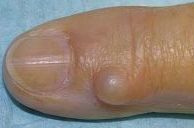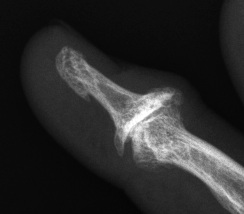Mucous Cysts
A mucous cyst is a small, soft harmless sac filled with a clear, thick joint fluid. It is attached to the joint by a stalk of tissue. The cysts can vary in size, and they can sometimes change in size. They form on the fingers, most commonly on the back of the finger between the last joint and the bottom of the fingernail.They are often associated with osteoarthritis (OA). Many times there may be an associated bone spur on the joint under the cyst. A history of trauma may be present, especially in younger patients.
Mucous cysts are frequently asymptomatic, but some patients may experience decreased range of motion in the nearby joint along with pain, tenderness, and nail deformity. Ridges in the nail may be present, and this is due to pressure of the cyst on the nailbed.
 |
 |
|
Mucous cyst
|
Bone spur at end of joint
|
Nonsurgical Treatment
Observation is often sufficient treatment for mucous cysts. Mucous cysts are not typically harmful and usually do not grow worse without treatment. However, sometimes a mucous cyst will rupture. When this occurs, it creates a path directly into the joint where bacteria could enter and cause a serious infection inside the joint. When this happens, antibiotics are applied directly to the site and the finger is wrapped in a dressing. Oral antibiotics are also prescribed. If the joint develops an infection despite these steps, surgery is required to clean out the joint.
Surgery
Surgery is recommended if you feel significant pain or if the cyst and skin appear ready to rupture.
In this procedure, the cyst, stalk, and any bone spurs on the joint are removed. If the skin on the finger is too closely attached to the cyst, a bit of the skin may need to be removed from the finger. If that's the case, a small skin graft is added to the spot. Surgery can usually be performed using regional anesthesia, meaning only the arm or finger is numbed with lidocaine.
Complications include a slight risk of infection. Even after removal, a mucous cyst may reappear, though this is rare. Patients should also be aware that removing a mucous cyst may not eliminate pain if the pain is from the underlying OA.
After Surgery
If you have surgery to remove a mucous cyst and a skin graft is used, you will wear a cast or splint for two weeks. Otherwise, the fingers can be moved sooner. You will be shown specific exercises to help you regain full motion in the finger. Exercises should be continued until you can move the finger normally without pain.